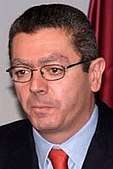1991 Madrilenian regional election
The 1991 Madrilenian regional election was held on Sunday, 26 May 1991, to elect the 3rd Assembly of the Autonomous Community of Madrid. All 101 seats in the Assembly were up for election. The election was held simultaneously with regional elections in twelve other autonomous communities and local elections all throughout Spain.
| |||||||||||||||||||||||||||||||||||||||||
All 101 seats in the Assembly of Madrid 51 seats needed for a majority | |||||||||||||||||||||||||||||||||||||||||
|---|---|---|---|---|---|---|---|---|---|---|---|---|---|---|---|---|---|---|---|---|---|---|---|---|---|---|---|---|---|---|---|---|---|---|---|---|---|---|---|---|---|
| Opinion polls | |||||||||||||||||||||||||||||||||||||||||
| Registered | 3,837,680 | ||||||||||||||||||||||||||||||||||||||||
| Turnout | 2,251,613 (58.7%) | ||||||||||||||||||||||||||||||||||||||||
| |||||||||||||||||||||||||||||||||||||||||
| |||||||||||||||||||||||||||||||||||||||||
The election saw the electoral collapse of the Democratic and Social Centre (CDS), which fell below the 5% threshold and lost all their 17 seats. Alberto Ruiz-Gallardón's People's Party (PP) emerged as the largest party in the community for the first time,[1] but was unable to form a government due to the lack of allies as a result of CDS expulsion from the Assembly. Consequently, Joaquín Leguina from the Spanish Socialist Workers' Party (PSOE) was re-elected President for a third term in office thanks to the support of United Left (IU).
Overview
Background
The 1987 election had resulted in a parliamentary deadlock. The opposition bloc of the People's Alliance (AP) and the CDS held 49 seats against 47 for the PSOE and IU. The ruling PSOE was initially able to hold on to power and have Joaquín Leguina re-elected President thanks to CDS' abstention, but nonetheless the government's majority remained precarious.
In 1988, an AP deputy, Nicolás Piñeiro Cuesta, resigned from the party as a result of ideological differences with the Madrid AP leader, Alberto Ruiz-Gallardón. Piñeiro launched his own party, the Independent Madrilenian Regional Party (PRIM), shortly after. Thereafter, in January 1989, AP along with other parties merged into the newly-created People's Party (PP).
In the first half of 1989, the PP and the CDS reached an agreement of cooperation in the Madrid Assembly, resulting in a motion of no confidence against Leguina's government in June 1989, in an attempt to replace it with a PP-CDS administration headed by Ruiz-Gallardón as Madrid President. To succeed, the motion needed the support of a majority of members, meaning that 49 votes were needed. With the PP and CDS having 48 members, Piñeiro's support was necessary. However, he abstained, and the United Left members blocked the motion alongside PSOE, resulting in the vote failing.[2]
Electoral system
The Assembly of Madrid was the devolved, unicameral legislature of the autonomous community of Madrid, having legislative power in regional matters as defined by the Spanish Constitution and the Madrilenian Statute of Autonomy, as well as the ability to vote confidence in or withdraw it from a President of the Community.[3] Voting for the Assembly was on the basis of universal suffrage, which comprised all nationals over eighteen, registered in the Community of Madrid and in full enjoyment of their political rights.
All members of the Assembly of Madrid were elected using the D'Hondt method and a closed list proportional representation, with a threshold of 5 percent of valid votes—which included blank ballots—being applied regionally. Parties not reaching the threshold were not taken into consideration for seat distribution. The Assembly was entitled to one member per each 50,000 inhabitants or fraction greater than 25,000.[3][4]
The electoral law provided that parties, federations, coalitions and groupings of electors were allowed to present lists of candidates. However, groupings of electors were required to secure the signature of at least 0.5 percent of the electors registered in the Community of Madrid. Electors were barred from signing for more than one list of candidates. Concurrently, parties and federations intending to enter in coalition to take part jointly at an election were required to inform the relevant Electoral Commission within ten days of the election being called.[4][5][6]
Election date
The term of the Assembly of Madrid expired four years after the date of its previous election. Legal amendments earlier in 1991 established that elections to the Assembly were to be fixed for the fourth Sunday of May every four years. The previous election was held on 10 June 1987, setting the election date for the Assembly on Sunday, 26 May 1991.[3][4][5][6]
After legal amendments in 1990, the President of the Community was granted the prerogative to dissolve the Assembly of Madrid and call a snap election, provided that no motion of no confidence was in process and that dissolution did not occur before one year had elapsed since the previous one.[7] In the event of an investiture process failing to elect a regional President within a two-month period from the first ballot, the Assembly was to be automatically dissolved and a fresh election called. Any snap election held as a result of these circumstances would not alter the period to the next ordinary election, with elected deputies merely serving out what remained of their four-year terms.[3]
Opinion polls
The table below lists voting intention estimates in reverse chronological order, showing the most recent first and using the dates when the survey fieldwork was done, as opposed to the date of publication. Where the fieldwork dates are unknown, the date of publication is given instead. The highest percentage figure in each polling survey is displayed with its background shaded in the leading party's colour. If a tie ensues, this is applied to the figures with the highest percentages. The "Lead" column on the right shows the percentage-point difference between the parties with the highest percentages in a given poll. When available, seat projections are also displayed below the voting estimates in a smaller font. 51 seats were required for an absolute majority in the Assembly of Madrid.
| Polling firm/Commissioner | Fieldwork date | Sample size | Turnout | LV | ARM | Lead | ||||||
|---|---|---|---|---|---|---|---|---|---|---|---|---|
| 1991 regional election | 26 May 1991 | N/A | 58.7 | 36.6 41 |
[lower-alpha 2] | 3.3 0 |
12.1 13 |
1.6 0 |
[lower-alpha 2] | 42.7 47 |
– | 6.1 |
| Sigma Dos/El Mundo[p 1][p 2] | 18 May 1991 | ? | ? | 32.3 35/36 |
[lower-alpha 2] | 5.4 6 |
14.6 16 |
3.4 0 |
[lower-alpha 2] | 39.7 44/45 |
– | 7.4 |
| Metra Seis/El Independiente[p 1][p 2] | 12 May 1991 | ? | ? | 36.2 39 |
[lower-alpha 2] | 8.7 9 |
10.5 11 |
4.2 4 |
[lower-alpha 2] | 35.1 38 |
– | 1.1 |
| Demoscopia/El País[p 1][p 2][p 3][p 4] | 4–7 May 1991 | 800 | ? | 36.4 42/43 |
[lower-alpha 2] | 4.5 0 |
11.7 13 |
4.3 0 |
[lower-alpha 2] | 38.9 45/46 |
– | 2.5 |
| 1989 general election | 29 Oct 1989 | N/A | 72.7 | 33.5 36 |
[lower-alpha 2] | 11.0 12 |
15.4 16 |
1.1 0 |
[lower-alpha 2] | 34.2 37 |
1.0 0 |
0.7 |
| 1989 EP election | 15 Jun 1989 | N/A | 58.5 | 35.5 41 |
[lower-alpha 2] | 9.3 11 |
8.4 9 |
1.8 0 |
[lower-alpha 2] | 28.0 33 |
6.1 7 |
7.5 |
| 1987 regional election | 10 Jun 1987 | N/A | 69.9 | 38.4 40 |
31.4 32 |
16.6 17 |
7.5 7 |
1.1 0 |
0.4 0 |
– | – | 7.0 |
Results
 | ||||||
| Parties and coalitions | Popular vote | Seats | ||||
|---|---|---|---|---|---|---|
| Votes | % | ±pp | Total | +/− | ||
| People's Party (PP)1 | 956,865 | 42.67 | +10.88 | 47 | +15 | |
| Spanish Socialist Workers' Party (PSOE) | 820,510 | 36.59 | –1.86 | 41 | +1 | |
| United Left (IU) | 270,558 | 12.07 | +4.59 | 13 | +6 | |
| Democratic and Social Centre (CDS) | 75,081 | 3.35 | –13.28 | 0 | –17 | |
| The Greens (LV) | 35,095 | 1.57 | +0.49 | 0 | ±0 | |
| The Ecologists (LE) | 12,897 | 0.58 | New | 0 | ±0 | |
| Green Union (UVE)2 | 8,903 | 0.40 | –0.13 | 0 | ±0 | |
| Madrilenian Independent Regional Party (PRIM) | 7,883 | 0.35 | New | 0 | ±0 | |
| Workers' Socialist Party (PST) | 7,736 | 0.34 | New | 0 | ±0 | |
| Party of Madrid (PAM) | 4,382 | 0.20 | New | 0 | ±0 | |
| Convergence of Independent Candidacies (CCI) | 2,248 | 0.10 | New | 0 | ±0 | |
| Revolutionary Workers' Party of Spain (PORE) | 2,187 | 0.10 | New | 0 | ±0 | |
| Aranjuez Independent Group (AIDA) | 1,899 | 0.08 | New | 0 | ±0 | |
| Alliance for the Republic (AxR)3 | 1,891 | 0.08 | –0.07 | 0 | ±0 | |
| Left Platform (PCE (m–l)–CRPE) | 1,847 | 0.08 | New | 0 | ±0 | |
| United Republican Action (ARU) | 1,346 | 0.06 | New | 0 | ±0 | |
| Madrilenian Centrist Union (UCM) | 1,329 | 0.06 | New | 0 | ±0 | |
| Generational Integration (IG) | 815 | 0.04 | New | 0 | ±0 | |
| Blank ballots | 28,872 | 1.29 | –0.45 | |||
| Total | 2,242,344 | 101 | +5 | |||
| Valid votes | 2,242,344 | 99.59 | +0.81 | |||
| Invalid votes | 9,269 | 0.41 | –0.81 | |||
| Votes cast / turnout | 2,251,613 | 58.67 | –11.20 | |||
| Abstentions | 1,586,067 | 41.33 | +11.20 | |||
| Registered voters | 3,837,680 | |||||
| Sources[8][9] | ||||||
Aftermath
Investiture processes to elect the President of the Community of Madrid required for an absolute majority—more than half the votes cast—to be obtained in the first ballot. If unsuccessful, a new ballot would be held 48 hours later requiring of a simple majority—more affirmative than negative votes—to succeed. If none of such majorities were achieved, successive candidate proposals could be processed under the same procedure. In the event of the investiture process failing to elect a regional President within a two-month period from the first ballot, the Assembly would be automatically dissolved and a snap election called.[3]
| Investiture Joaquín Leguina (PSOE) | ||
| Ballot → | 11 July 1991 | |
|---|---|---|
| Required majority → | 51 out of 101 | |
Yes
|
54 / 101 | |
No
|
47 / 101 | |
| Abstentions | 0 / 101 | |
| Absentees | 0 / 101 | |
| Sources[9] | ||
References
- Opinion poll sources
- "Seis comunidades dependen de pactos". ABC (in Spanish). 20 May 1991.
- "Las elecciones de 26-5-91". CEPC (in Spanish). August 1991.
- "Leguina y Barranco precisarán del pacto". El País (in Spanish). 19 May 1991.
- "Ficha técnica". El País (in Spanish). 19 May 1991.
- Other
- Historia Electoral - Elections to the Madrid Assembly. Retrieved 2015-05-17.
- "Leguina remains at the head of the Community of Madrid in a very precarious situation to rule". El País (in Spanish). 1989-06-22.
- "Statute of Autonomy of the Community of Madrid of 1983". Organic Law No. 3 of 25 February 1983. Official State Gazette (in Spanish). Retrieved 22 February 2017.
- "Community of Madrid Electoral Law of 1986". Law No. 11 of 16 November 1986. Official Gazette of the Community of Madrid (in Spanish). Retrieved 22 February 2017.
- "General Electoral System Organic Law of 1985". Organic Law No. 5 of 19 June 1985. Official State Gazette (in Spanish). Retrieved 28 December 2016.
- "Representation of the people Institutional Act". www.juntaelectoralcentral.es. Central Electoral Commission. Retrieved 16 June 2017.
- "1990 law regulating the power of dissolution of the Assembly of Madrid by the President of the Community". Law No. 5 of 17 May 1990. Official Gazette of the Community of Madrid (in Spanish). Retrieved 14 September 2017.
- "Summary and electoral results of the III Legislature". asambleamadrid.es (in Spanish). Assembly of Madrid. Retrieved 30 September 2017.
- "Assembly of Madrid elections since 1983". historiaelectoral.com (in Spanish). Electoral History. Retrieved 30 September 2017.

_Felipe_Gonz%C3%A1lez_recibe_al_presidente_de_la_Comunidad_de_Madrid_(cropped)_(cropped).jpeg)
